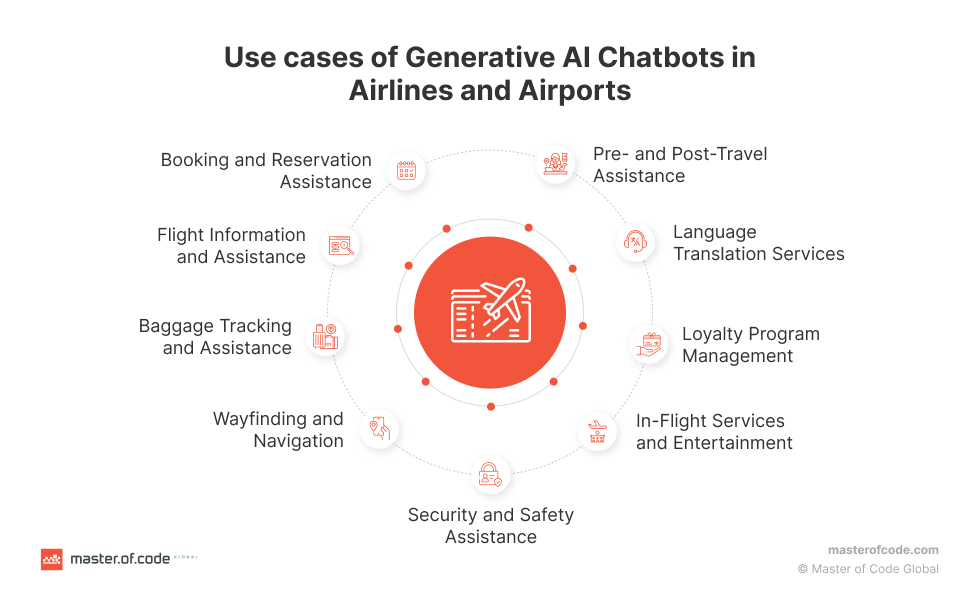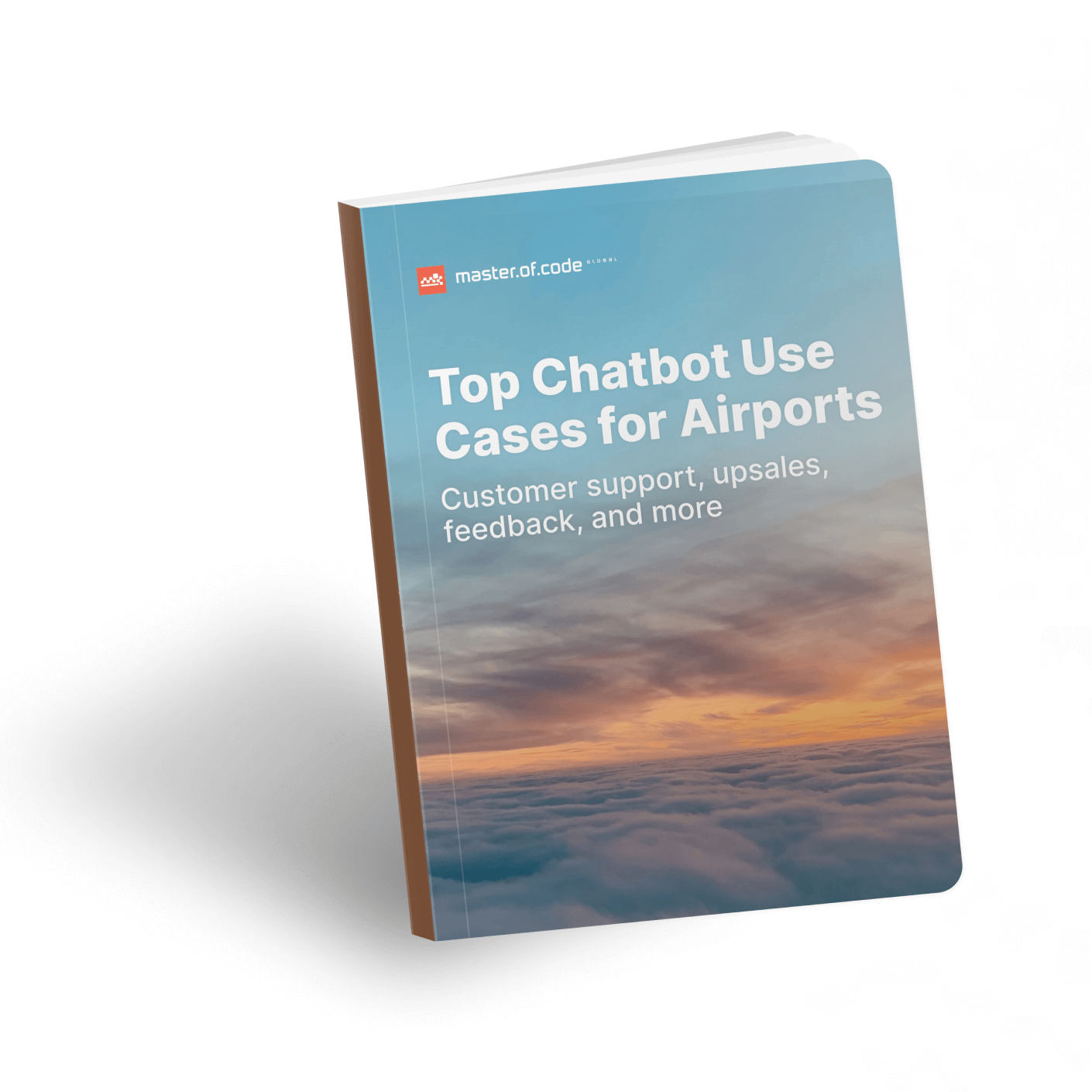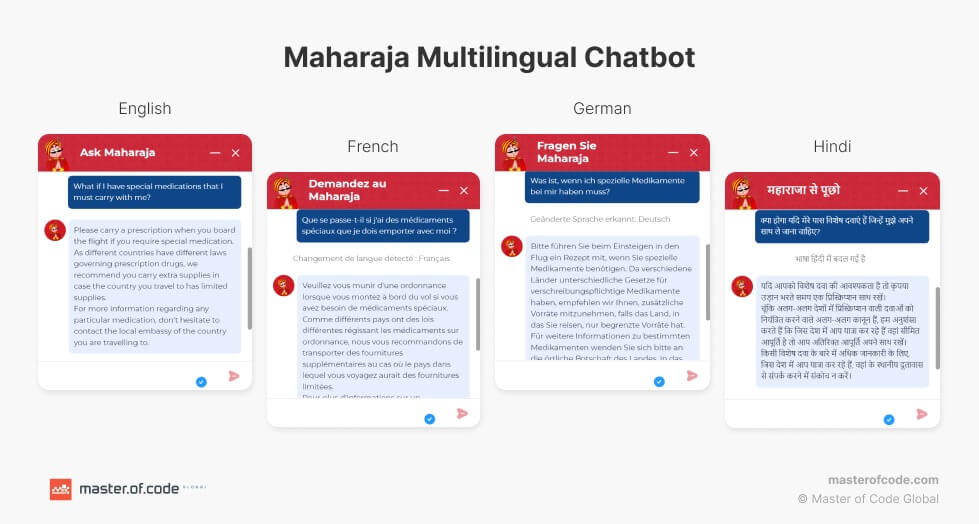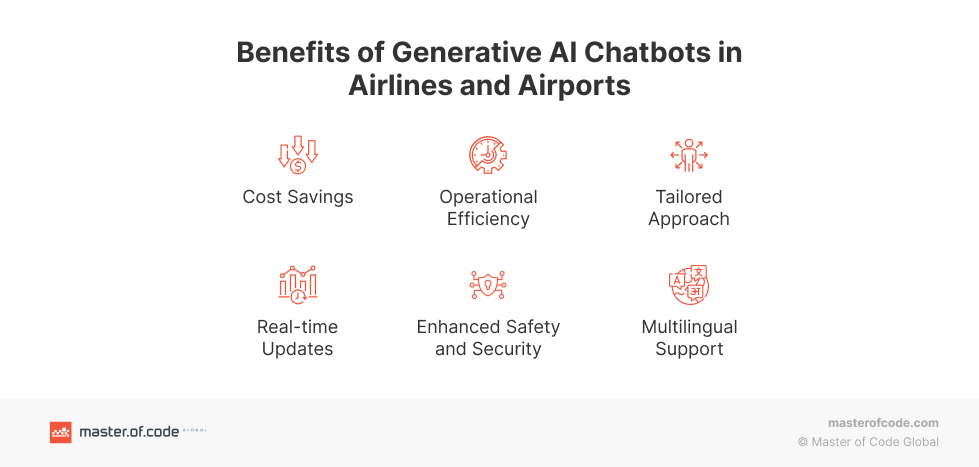Numerous companies across various industries are adopting Generative AI and other forms of artificial intelligence to drive revenue growth, minimize expenses, boost customer satisfaction, and raise the speed and quality of decision-making processes.
According to Juniper Research, companies are expected to save $11 billion each year by 2023 through the utilization of tools like ChatGPT. Furthermore, as indicated by a report from Salesforce, 64% of consumers and 80% of business buyers anticipate real-time responses and interactions from companies. By implementing Generative AI to deliver fast responses to customer questions, airlines can fulfill these expectations and improve client journey.
In PWC’s latest report, it was identified that the airline industry has the largest disparity of 33% between expectations and reality. It is a significant challenge that needs to be addressed. However, Generative AI is poised to assist in elevating the airline industry by delivering a more personalized and efficient experience for people.
Safe adoption of Generative AI is essential in this context. Bots for airports and airlines assist travelers by providing flight information, directions, and addressing various questions. With the use of artificial intelligence, aviation and airlines can analyze data, including flight history and preferences, to offer tailored recommendations for services such as dining or shopping. By predicting demand and adjusting inventory levels accordingly, essential products can be made available to people. The agents can also assist airports in scheduling and prioritizing maintenance tasks for facilities and equipment based on factors such as usage patterns and historical performance. Generative AI has the potential to change the aviation industry by delivering intelligent services to travelers and upgrading operational efficiency. So let’s take a closer look at the use cases of using artificial intelligence in aviation and airlines.
Table of Contents
Safe Starts with Generative AI
While the benefits of Gen AI in aviation are transformative, it’s crucial to recognize the potential risks and how to mitigate them. In an industry where safety, compliance, and public trust are paramount, even small errors can have big consequences. Risks range from misinformation due to model hallucinations and biases in recommendation systems to data privacy concerns, especially with sensitive information.
To deploy GenAI responsibly, aviation businesses must implement robust validation processes, guarantee human-in-the-loop oversight for critical decisions, and invest in explainable AI models. Frequent auditing, multilingual testing, and scenario-based simulations are key to minimizing unintended outputs. Data encryption and strict access controls also help protect personal information.
By addressing these challenges early, airlines and airports can confidently harness Generative AI to boost, not compromise, safety and operational excellence.
See It in Action: Airport Assistant Demo
Curious how Generative AI works in a real-world airport environment? Meet our Airport Assistant—a smart conversational solution designed to elevate the traveler experience from check-in to takeoff.
With this AI-powered assistant, passengers can:
- Get real-time flight information and gate updates
- Navigate terminals with step-by-step directions
- Receive baggage help, delay alerts, and safety instructions
- Access personalized support in multiple languages
This showcase highlights one of the most impactful practical Generative AI examples in use today – bringing together real-time interaction, operational efficiency, and multilingual support for modern airports. Ready to take your operations to the next level? Let’s talk about how we can build a custom GenAI assistant tailored to your facility’s needs.
Use Cases of Generative AI in Airlines

Booking and Reservation Assistance
Generative AI bots can provide valuable assistance to people when it comes to booking flights, selecting seats, and making reservations for various airport services. These tools are equipped with the ability to understand and process requests, allowing them to offer personalized recommendations and secure a smooth booking experience. Over the past year, we’ve helped our clients invest in Conversational AI solutions and increased 7.67x weekly bookings or conversion rate 3x higher since the bot was launched.
Learn how chatbots assist passengers and streamline airline workflows.

Passengers can interact with the airline chatbot to inquire about flight availability, fares, and schedules. Based on their preferences and requirements, the bot can give suitable options, including alternative flights or nearby airports, helping people make informed decisions. The tool can also assist in seat selection, allowing travelers to choose seats based on their preferences, such as window or aisle seats, or proximity to other customers.
Furthermore, Generative AI can facilitate reservations for additional airport services, such as airport lounges or car rentals. Flyers can specify their choices, such as desired amenities in a lounge or specific car models for rentals, and the assistant can recommend suitable options based on availability and preferences. Agents in aviation suggest alternatives that align with the traveler’s chosen criteria, making the booking process more convenient and tailored to individual needs.
Etihad Airways is preparing to introduce a new feature that enables customers to make flight bookings using artificial intelligence. This innovative technology allows clients to input their basic details into the BOTIM chat app, which will then handle the entire booking process on their behalf. One of the notable features of the BOTIM app is its generative pre-trained transformer (GPT), which has gained global recognition since OpenAI’s ChatGPT was launched in November 2022. What sets Etihad Airways apart is that their GPT will be the first to support both English and Arabic languages, giving a more inclusive and accessible experience.
In addition to modifying the booking process, Etihad Airways is embracing technology in other aspects of their operations. The airline recently introduced a complimentary onboard chat service on its widebody aircraft, enabling people to use popular chat apps like WhatsApp, WeChat, and Messenger throughout their flight.
Another example is Air India’s AI-powered virtual agent, “Maharaja,” which handles bookings, refunds, and flight changes across 1,300 topics in multiple languages, streamlining service and making support more accessible for a diverse user base.
Flight Information and Assistance
Generative AI assistants can be deployed at airports to provide real-time flight information and assistance to passengers. They can answer queries about flight schedules, delays, gate changes, baggage information, and more, helping flyers stay informed and reducing the workload on airport staff.
As per Accenture’s findings, 83% of airline customers expect to receive responses to their inquiries within a 24-hour timeframe. By leveraging Generative AI, airlines can offer real-time responses to user queries, significantly reducing their response times and meeting client expectations promptly.
Gen AI can be implemented at airports to offer real-time flight information and assistance to travelers. For instance, a customers may approach the bot and ask about their flight schedule or any potential delays. The airport chatbot can promptly offer accurate and up-to-date information, making sure that guests are well-informed about their flights.
In another scenario, if there is a gate change, travelers can rely on the tool to notify them and give directions to the new gate. This helps prevent confusion and guarantees that clients reach their departure gates without any issues.
Additionally, Generative AI can assist with questions related to baggage. People can ask about baggage allowances, restrictions, and procedures. The tool can provide clear and concise information, verifying that customers understand the requirements and have a hassle-free experience during check-in and baggage handling.
American Airlines is currently testing a GenAI chat assistant integrated into its app and website. It supports travelers during weather-related disruptions by guiding them through the rebooking process when flights are delayed or canceled, helping reduce service friction during high-stress situations.
Language Translation Services
Airports serve a diverse range of international travelers who may encounter language barriers during their journey. Generative AI tools, equipped with advanced natural language processing capabilities, can play a vital role in bridging these communication gaps by offering language translation services.
Passengers can rely on Generative AI to communicate with airport personnel or seek information in their preferred language. The bot can accurately translate their questions, inquiries, or directions into the desired language, offering clear and effective communication.
For example, a traveler who speaks Spanish can approach the bot and ask for directions to a specific gate in their native language. The assistant can swiftly translate the question and provide detailed directions in English or any other language required. This seamless translation process saves time and eliminates confusion for travelers.
Generative AI bots for aviation can support multiple languages, allowing them to cater to a wide range of travelers from different linguistic backgrounds. By using their natural language processing capabilities, these tools can offer accurate translations for both simple and complex inquiries, making sure that flyers receive the information they need in a language they understand.
Air India has gotten on a digital transformation journey by implementing a ChatGPT-driven bot and other innovative initiatives. The airline has invested an initial sum of USD 200 million in modernizing its digital systems. Maharaja, Air India’s AI-powered tool has undergone extensive training to address a wide range of customer questions related to bookings, cancellations, baggage policies, loyalty programs, and more.

Applying the power of ChatGPT technology, Maharaja is now equipped to give comprehensive assistance for all aspects of travel. Whether you have questions about baggage, bugles, or even beagles, Maharaja is there to lend a helping hand. With each interaction, the agent continues to improve its knowledge and capabilities. Engaging with Maharaja is effortless – simply start a conversation in your preferred language, which currently includes Hindi, English, French, and German. The tool understands and responds accordingly, and you can switch to another language at any time by typing in the desired language.
Moreover, language translation offerings can extend beyond basic directions or questions. It can also assist with translations for essential airport services, such as check-in procedures, security protocols, baggage instructions, or immigration requirements. By breaking down language barriers, Generative AI contributes to a smoother and more inclusive travel experience for international guests. Air India’s chatbot exemplifies this approach. It currently supports Hindi, English, German, and French for customer interactions, elevating accessibility for a global audience.
Wayfinding and Navigation
Navigating through airports, with their complex and expansive layouts, can often be a source of confusion and stress for people. However, Generative AI bots have the potential to alleviate these challenges by offering informative and interactive wayfinding and navigation assistance. Travelers can rely on agents in airports to offer precise directions to various airport destinations, including departure gates, baggage claim areas, lounges, restaurants, or other facilities. The bot can provide step-by-step instructions tailored to the specific location within the airport.
To raise the navigation experience, Generative AI in airport can even display maps on mobile devices, making sure they have a visual representation of their route. These maps can highlight key landmarks, restrooms, ATMs, or other amenities along the way, making it easier for people to identify their surroundings and follow the recommended path.
Generative AI in aviation can adapt to changing circumstances within the airport. For instance, if there is a gate change or unexpected closure of a facility, the bot can quickly update the directions and give alternative routes to guide clients effectively.
Lufthansa is actively exploring advanced Generative AI implementations, including wayfinding and dynamic indoor navigation systems as part of its broader cloud transformation strategy. These innovations are designed to help users navigate complex terminals more intuitively using real-time updates and digital guidance tools.
Security and Safety Assistance
Providing the safety and security of passengers is of paramount importance for airports. GenAI bots in airports can play a significant role in this area by offering comprehensive assistance and guidance to flyers.
One of the key aspects where chatbots can assist is in delivering information on security procedures. Travelers can interact with the agent to learn about the items that are allowed in carry-on luggage, prohibited items, and any specific requirements for screening. The tool can offer detailed explanations, confirming that customers are well-informed and compliant with security regulations, ultimately expediting the screening process.
In addition to routine security procedures, Generative AI bots can also be instrumental in emergency situations or incidents. These aviation tools can provide real-time updates and instructions to reinforce safety. For example, in the event of a security threat or natural disaster, the agent can deliver important information, such as evacuation procedures, designated safe zones, or emergency contact numbers. This real-time assistance can help travelers navigate through unexpected situations more effectively and mitigate potential risks.
The technology can improve security measures at airports through face identification and verification systems. By utilizing multiple photos taken from different angles, the technology can create a comprehensive full-face picture of a person. This enables airports to more accurately identify and verify the identity of travelers, improving security protocols and reducing the possibility of fraudulent activities.
A real-world application of this is the TSA’s current pilot program, which uses Generative AI to assist screening officers during security checks. According to Federal News Network, the AI provides real-time training and support, helping staff interpret scans more accurately and speed up person processing without compromising safety.
In-Flight Services and Entertainment
Airlines have the opportunity to raise in-flight services and entertainment options by using bots. These airline agents can offer a range of offerings to people, catering to their individual preferences and offering an enjoyable in-flight experience.
Passengers can use the airline bot to request special meals based on their dietary requirements or tastes. Whether it’s a vegetarian, gluten-free, or kosher meal, the assistant can assist in making the necessary arrangements, certifying that travelers are provided with suitable meal options during their flight.
Moreover, Generative AI tools can serve as a valuable resource to inquire about onboard amenities. Travelers can ask questions regarding available facilities, such as Wi-Fi availability, charging ports, or the availability of in-flight entertainment systems. The assistant can promptly supply information and help people make the most of the available onboard amenities.
Additionally, Generative AI tools for airlines can offer individualized entertainment recommendations to clients. By analyzing preferences, such as favorite genres, movies, or music, the chatbot can suggest tailored entertainment options, verifying that guests have access to content that aligns with their interests.
Furthermore, the airline bots can introduce interactive elements to the in-flight experience, such as games or quizzes. Flyers can engage with the assistant in interactive activities, providing entertainment and a way to pass the time during the flight. This feature adds an element of fun and engagement to the in-flight journey, upgrading the overall journey.
Several leading airlines are already pioneering these AI-driven enhancements. Lufthansa, for example, is evolving its mobile app into a full-fledged conversational assistant that delivers real-time, personalized support throughout the travel journey, including during the flight.
Japan Airlines is also innovating with AI-powered in-flight entertainment, using Google’s Veo 2 and Gemini AI to generate 60-second destination videos tailored to each route. These customized films appear on seatback screens and are produced in under 15 hours – optimizing what once took weeks.
Meanwhile, Qatar Airways has introduced “Sama 2.0,” a virtual AI cabin attendant available via app and kiosks. Sama provides travelers with unique recommendations, empathetic support, and interactive 3D airport navigation, creating a highly immersive travel experience.
Loyalty Program Management
Airlines frequently establish loyalty programs to reward and retain their frequent flyers. Generative AI bots present an excellent opportunity to refine the management of these loyalty programs, supplying people with a seamless and rewarding journey.
Passengers can rely on tools to efficiently manage their loyalty accounts. By interacting with the airline bot, people can check their points or miles balance in real-time. This feature keeps flyers updated on their current loyalty status, empowering them to make informed decisions regarding their rewards and benefits.
The airline chatbot can also provide valuable information on available rewards within the loyalty program. Customers can inquire about various redemption options, such as free flights, cabin upgrades, access to airport lounges, or exclusive discounts. The bot can grant detailed information on the requirements and availability of these rewards, allowing flyers to make well-informed choices.
The implementation of Generative AI enables efficient and convenient communication at every stage of the traveler’s journey, leading to increased revenue and reduced operational costs. This focused messaging approach facilitates smooth and hassle-free bookings, ultimately resulting in a higher number of upgrades.
As reported by Persado, an airline successfully increased its revenue by 48% through the utilization of a web banner promoting first-class seat bookings. This significant boost in revenue amounted to an additional $8 million in earnings for the airline. Generative AI technology for airlines enables operators to effectively promote additional products or services to customers through individualized and tailored communication strategies.
Generative AI can assist people in the process of redeeming rewards. Clients can interact with the airline bot to initiate the redemption process, whether it’s booking a flight using loyalty points, upgrading their seat, or availing themselves of other program benefits. The assistant can guide clients through the necessary steps, offering a seamless and efficient redemption experience. A strong example of this is Air India’s “Maharaja” bot, which also manages frequent flyer awards and related inquiries, simplifying loyalty tracking and redemption for its diverse client base.
Baggage Tracking and Assistance
Generative AI in airlines offers valuable support to people in tracking their baggage throughout their journey. Flyers can input their baggage information, such as the bag tag number, into the bot, which then applies advanced tracking systems to provide real-time updates on the location of their bags.
This feature significantly reduces stress and uncertainty for travelers, as they can easily check the status of their baggage right from their mobile devices. The assistant can inform flyers about the current whereabouts of their bags, whether they are in transit, loaded onto the aircraft, or ready for pickup at the destination. This information allows people to have peace of mind and better plan their next steps.
Moreover, bots can assist people in reporting lost or damaged baggage. If a person discovers that their baggage is missing or has been damaged during the journey, they can notify the tool, which will guide them through the necessary steps for reporting the incident.
The agent can provide relevant instructions on filling out the required forms, documenting the details of the baggage, and connecting the passenger with the appropriate airport staff or airline representatives who can assist further. By automating the process and offering clear guidance, the airport bot helps expedite the resolution of such issues.
Air India’s AI agent also addresses baggage-related inquiries, such as allowance details, and likely supports tracking and issue reporting via its chatbot, ensuring travelers get fast, reliable help when dealing with their luggage.
Pre- and Post-Travel Assistance
Generative AI in travel industry provides extensive pre- and post-travel assistance, guaranteeing a smooth and convenient experience throughout their journey.
Before the trip, the airline agent serves as a valuable resource for people, offering essential information on travel requirements. This includes details on visa regulations, passport validity, and specific entry or health protocols, such as COVID-19 travel restrictions. Generative AI can give accurate and up-to-date information, making sure that customers are well-prepared and compliant with the necessary travel guidelines.
Additionally, bots can assist travelers in planning their travel itineraries. Flyers can seek recommendations on popular attractions, local customs, or transportation options at their destination. The airline agent can offer individualized suggestions based on individual tastes, budget, or travel dates, elevating their travel planning experience.
After the trip, the airline tool continues to provide valuable support. Passengers can use the bot to submit feedback or reviews about their travel journey. This feedback can help airlines or airports identify areas for improvement and raise their services in the future. Additionally, the agent can assist people in handling refund or compensation requests, should any issues arise during the journey.
Moreover, the chatbot can address any post-travel questions or concerns that travelers may have. Whether it’s a lost item, a billing discrepancy, or general inquiries about their travel experience, the airline bot can offer prompt and accurate responses. This confirms that customers receive the necessary assistance and have their concerns addressed in a timely manner.
JetBlue exemplifies the power of Generative AI in these phases. The airline uses artificial intelligence to automate pre- and post-travel customer service interactions, reportedly saving 73,000 hours per quarter, improving responsiveness while reducing workload on support teams.
Use Cases of Generative AI in Aviation
Artificial intelligence is taking flight beyond customer service, transforming key operational areas within the aviation sector. Here’s how airlines and manufacturers are unlocking new value across the board.
Streamline Aircraft Maintenance and Sourcing
Master of Code Global developed an AI-powered parts sourcing chatbot for airlines, addressing high call volumes and enhancing operational efficiency. Initially launched as a web-based assistant, the bot was later expanded to voice and SMS, providing users with a seamless experience across multiple communication channels.
The AI solution handles tasks like checking part availability, tracking orders, and answering customer inquiries. By reducing reliance on phone calls and automating routine queries, it has significantly improved the speed and scalability of parts sourcing, while boosting customer satisfaction through faster, more reliable support.
Personalize Pilot and Crew Training
Emirates is utilizing an immersive XR platform powered by AI to advance cabin crew training and onboarding. This next-gen system adapts to individual learning speeds and simulates real-world scenarios – elevating retention, reducing classroom time, and accelerating readiness for in-flight service.
Optimize Flight Routes and Schedules
Alaska Airlines’ “Flyways” acts as an AI-driven assistant for dispatchers. By analyzing weather conditions, air traffic, and airport congestion in real time, it recommends optimal flight paths. During a six-month pilot, the tool saved 480,000 gallons of jet fuel and cut 4,600 tons of carbon emissions.
Support Predictive Maintenance
Southwest Airlines uses AIXI’s LLM-based platform to monitor its fleet of over 800 aircraft. The system identifies potential faults and suggests fixes proactively, reducing unplanned downtime, improving airplane availability, and boosting safety.
Create Digital Twins
Generative AI deployments are enabling airlines and OEMs to build replicas of aircraft, engines, and ground systems. These digital twins are used to simulate performance, test upgrades, and forecast maintenance needs before physical changes are made.
Plan and Optimize Airports
The authorities are turning to GenAI to design smarter, more efficient terminals. These models simulate passenger flows, predict bottlenecks, and validate infrastructure plans, enabling better decision-making long before construction begins.
Reinvent Aviation Workflows
Airbus is pioneering the use of Generative AI for airline operations across design, engineering, and production. From optimizing wing structures to generating code for manufacturing processes, the company is reinventing traditional workflows to boost speed, precision, and sustainability.
Benefits of Generative AI in Aviation and Airlines

- Cost Savings: Implementing Generative AI can lead to significant cost savings for airlines. They can handle routine customer inquiries, reducing the need for large user support teams. This cost-effective solution allows airlines to allocate resources more efficiently and invest in other areas of their business.
- Operational Efficiency: Gen AI can handle a large volume of inquiries simultaneously, freeing up human agents to focus on more complex tasks. This improves operational efficiency by reducing wait times, increasing productivity, and optimizing resource allocation.
- Tailored Approach: By analyzing data and preferences, Generative AI bots can offer individualized recommendations for services like seat upgrades, in-flight entertainment, or special offers. This tailored approach enhances the customer experience and increases the likelihood of upselling.
- Real-time Updates: Generative AI can provide real-time updates on flight statuses, delays, and gate changes, keeping passengers informed and minimizing confusion. By delivering timely and accurate information, airports can improve satisfaction and reduce the number of inquiries directed to staff.
- Enhanced Safety and Security: Virtual assistants can offer guidance on security procedures, alert people about potential safety hazards or emergencies, and offer instructions during critical situations. By proactively monitoring security systems and integrating with existing airport infrastructure, artificial intelligence can contribute to improve safety and security measures.
- Multilingual Support: Сhatbots can support multiple languages, assisting international travelers who may face language barriers. By giving language translation services, airports can improve communication and provide a seamless journey for travelers from different linguistic backgrounds.
- Disruption Management: Flight disturbances are inevitable, but Generative AI can help minimize their impact. Digital tools can rebook flyers, offer compensation, and suggest alternative travel options in real time. This guarantees quick resolutions, reduces stress for travelers, and protects airline’s reputation during service interruptions.
- Loyalty Program Enhancement: Generative AI helps elevate frequent flyer programs by personalizing the entire loyalty experience. Travelers can check point balances, receive tailored reward suggestions, and redeem benefits instantly – all through digital interfaces. This proactive engagement boosts program participation and retention.
- Predictive Maintenance & Scenario Planning: By analyzing real-time data from aircraft sensors and historical performance logs, Generative AI foresees maintenance needs before issues arise. It can also simulate various operational scenarios, helping airlines prepare for delays, staffing shortages, or unexpected events with data-driven confidence.
- Flight Path & Fuel Optimization: Digital tools process vast datasets, including weather forecasts and traffic patterns, to recommend the most efficient flight routes. This helps airlines save on fuel costs, reduce carbon emissions, and operate more sustainably without compromising schedule reliability.
- Revenue Management & Ancillary Revenue: AI improves pricing strategies by forecasting demand, adjusting fares dynamically, and identifying high-value customers. It also promotes ancillary offerings – like baggage upgrades or travel insurance – at optimal moments, driving higher revenue and profitability.
- Enhanced Product & Service Recommendations: Generative AI personalizes every touchpoint of the individual journey by recommending services and products aligned with one’s tastes and habits. From preferred meals to entertainment options, these suggestions increase satisfaction and ancillary conversions.
Conclusion
In conclusion, the integration of AI agents in airports and airlines offers numerous advantages. These bots efficiently help travelers by providing accurate flight information, tailoring services according to specific preferences, anticipating demand for essential products, and optimizing maintenance activities. Moreover, they boost safety and security measures by delivering valuable guidance, timely alerts, and crucial instructions during emergencies. Finally, Generative AI solutions have the potential to revolutionize the airport, aviation and airline experience, offering intelligent offerings, automating operations, and offering a seamless journey for travelers.






